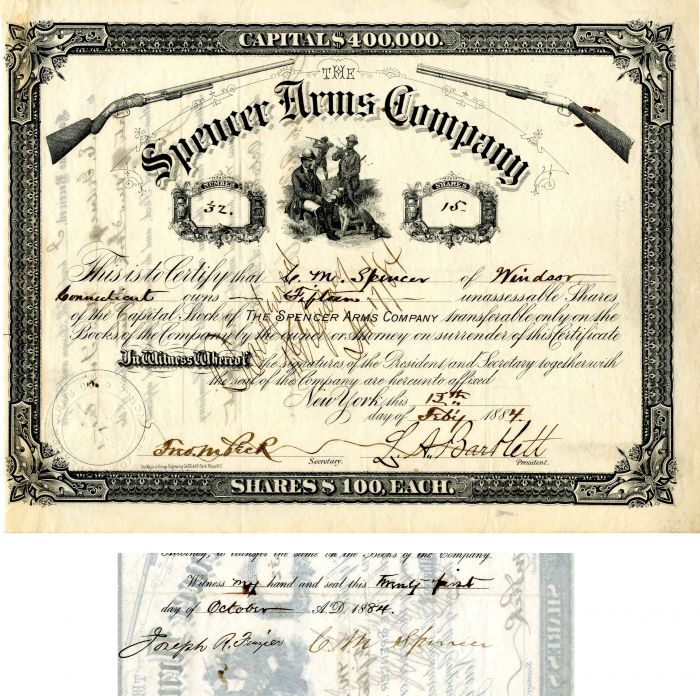Spencer Arms Co. - Issued to and Signed by Christopher M. Spencer
Inv# GN1016 Stock
Stock printed by Major & Knapp Engraving, N.Y. Issued to and signed on back by C. M. Spencer, who patented the breech-loading repeating rifle in 1860 which allowed ammunition to be loaded into a chamber at the rear of the gun barrel rather than at the muzzle. By 1862 he had established the Spencer Repeating rifle Company in Boston, Massachusetts, in order to produce the firearm for the Union army during the American Civil War. The Spencer breech-loading repeating rifle became the standard firearm for the Union cavalry in the latter stages of the Civil War.

Christopher Miner Spencer (June 20, 1833 – January 14, 1922) was an American inventor, from Manchester, Connecticut, who invented the Spencer repeating rifle, one of the earliest models of lever-action rifle, a steam powered "horseless carriage", and several other inventions. He developed the first fully automatic turret lathe, which in its small- to medium-sized form is also known as a screw machine. Spencer worked for Samuel Colt’s factory, where he learned the arms-making trade. Although the Spencer rifle had been developed as early as 1859, it was not initially used by the Union. On August 18, 1863, Christopher Spencer walked into the White House carrying one of his rifles and a supply of cartridges. He walked past the sentries, and into Abraham Lincoln's office. After some discussion, he returned the following afternoon, when Spencer and Lincoln were joined by Edwin Stanton, Secretary of War and other officials, and the group then proceeded to walk out on the Mall. Near the site of the Washington Monument, they engaged in target shooting. Subsequent to that meeting, the US ordered some 13,171 rifles and carbines, along with some 58 million rounds of ammunition. General Ulysses S. Grant declared Spencer rifles "the best breech-loading arms available". Total wartime production approached 100,000 rifles. Many veterans took these rifles home with them after the war and their rifles saw widespread use on the western frontier. With so many military surplus rifles available, there was little post-war demand for new rifles; and Spencer was unable to recover investments made in manufacturing machinery. Spencer Repeating Rifle Company declaring bankruptcy in 1868; and assets were acquired by Oliver Winchester for $200,000 in 1869. In 1868, while at the Roper Repeating Arms Company in Amherst, Massachusetts, he worked with Charles E. Billings, and Sylvester H. Roper. After Roper's firearms company failed, and the following year, 1869, the Billings and Spencer founded a partnership in Hartford, Connecticut called Billings & Spencer, which would manufacture sewing machines, drop-forged hand tools, and machine tools. Around 1882, Spencer started a new company, the Spencer Arms Company, in Windsor, Connecticut. Its most remarkable product was likely the Spencer Pump-Action Shotgun. Produced between 1882 and 1889, this was the first commercially successful slide-action (or pump-action) shotgun. Most were manufactured in 12-gauge with 10-gauge being an uncommon variant. Once again faced with financial hardships, Spencer's company and his patents were purchased circa 1890 by Francis Bannerman & Sons of New York who continued to manufacture his shotgun until around 1907.
A stock certificate is issued by businesses, usually companies. A stock is part of the permanent finance of a business. Normally, they are never repaid, and the investor can recover his/her money only by selling to another investor. Most stocks, or also called shares, earn dividends, at the business's discretion, depending on how well it has traded. A stockholder or shareholder is a part-owner of the business that issued the stock certificates.










Ebay ID: labarre_galleries